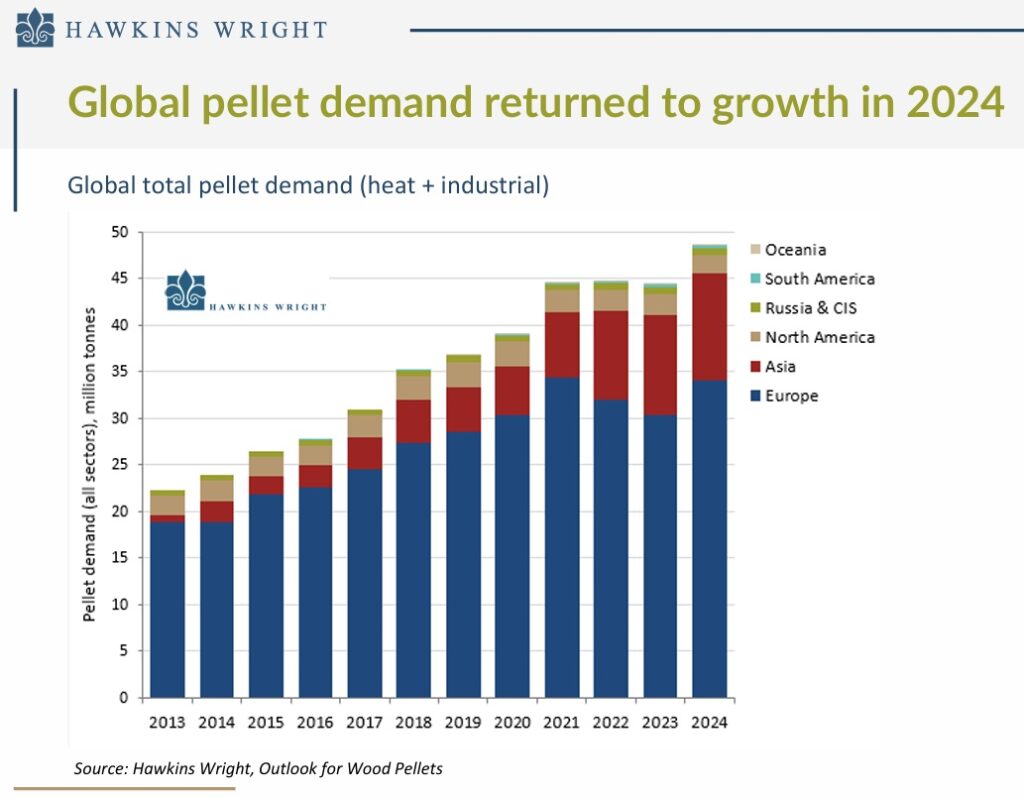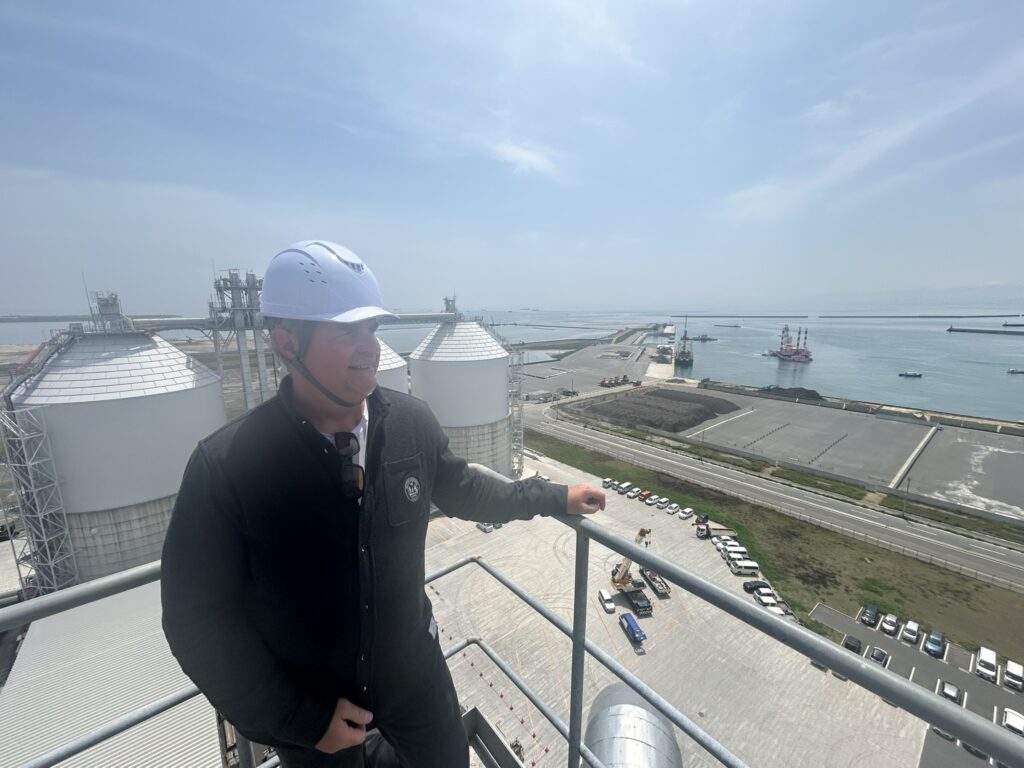This past May, the Wood Pellet Association of Canada (WPAC) team participated in the 2025 BioInnovAsia Conference in Tokyo, a major gathering of international biomass stakeholders that continues to grow in scale and influence. The event underscored the shifting landscape—one where biomass is gaining recognition not only as a renewable energy source, but as a vital tool in decarbonizing some of the world’s toughest sectors.
The conference featured two parallel tracks—Biofuels & Biocarbon Asia and Biomass Pellet Trade Asia—and drew strong participation from Japan, South Korea, and across the region. Attendees included power producers, industrial buyers, project developers, and policymakers, all with a shared interest in how sustainable biomass can help meet energy security and climate goals.
For WPAC and the broader Canadian pellet sector, the event was a great opportunity to reinforce Canada’s reputation as a trusted supplier of low-emission, high-quality pellets from responsibly managed, third-party certified sources. It also offered critical insights into where the market is headed, and how we must evolve to stay ahead.
Global Market Trends and Japan’s Biomass Evolution
Global demand for wood pellets—used in both heat and industrial sectors—has steadily increased over the past decade, with total consumption projected to exceed 45 million tonnes in 2024 (see chart). While Europe remains the dominant market, Asia is emerging as a key growth driver, accounting for a rising share of demand.

Japan remains a top-tier market for Canadian pellets, with more than 290 biomass power plants operating nationwide and capacity expected to grow by 6,000 megawatts by 2030. Eleven new facilities slated to come online in 2025 alone could drive demand for an additional 1.1 million tonnes of biomass fuel.
But change is coming. The government’s long-standing feed-in tariff (FIT) program, which has driven much of Japan’s biomass growth, will begin phasing out in the 2030s. As the sector prepares for a post-subsidy future, competitiveness is becoming a central theme. Fuel cost, combustion efficiency, and pellet quality are under heightened scrutiny. Buyers are tightening specifications—low ash, low fines, and durability are top priorities. Fortunately, these are areas where Canadian producers excel, giving us a critical edge in a more discerning market.
Industrial Demand Reshaping Biomass Markets
What’s new—and gaining momentum—is the role of biomass in hard-to-abate sectors like cement and steel. Biocarbon products, such as torrefied and carbonized pellets, are emerging as renewable alternatives to fossil coal. These markets are still developing, but demand signals are clear: industrial users want high-performance carbon products that meet strict physical and chemical requirements, and they want them from sustainable sources.
This represents a promising area of growth for Canadian producers willing to invest in advanced processing technology. Countries like Japan are actively exploring these alternatives, not just for energy generation but as integral parts of decarbonizing their industrial base.
BECCS: A Window Into the Future
One of the most talked-about technologies at the conference was BECCS—bioenergy with carbon capture and storage. BECCS is gaining traction globally as a viable pathway to achieve net-negative emissions. Several case studies highlighted how large-scale biomass power facilities can be retrofitted with carbon capture systems to permanently remove CO₂ from the atmosphere.
The implications for Canada’s pellet sector are significant. If carbon removal markets mature and policy support solidifies, pellet-fueled BECCS facilities could provide both clean energy and high-integrity carbon offsets. But sustainability is non-negotiable—any BECCS project using biomass must demonstrate robust traceability and responsible sourcing. That’s another area where Canada has a compelling story to tell.
Stronger Ties and Shared Vision

Throughout the event, WPAC and other Canadian representatives engaged with Japanese utilities, industrial buyers, and government ministries to advance understanding of Canada’s approach to sustainable forest management. These conversations highlighted the rigour with which Canadian forests are managed and strength of Canada’s forest certification record – critical factors in ensuring ongoing confidence in Canadian biomass as a climate-aligned fuel source.
The presence of British Columbia’s Chief Forester, Shane Berg, added valuable depth to these engagements. His contributions in public and bilateral meetings helped underline the province’s leadership in sustainable forestry and its role in ensuring the long-term integrity of Canada’s biomass supply. His presence reinforced Canada’s role as a global leader in sustainable forestry and a dependable partner in the clean energy transition.
A visit to the Kanda Biomass Power Station further illustrated this alignment. The facility, which runs almost entirely on imported biomass including wood pellets from British Columbia, highlights how clean energy, technology, and sound sourcing practices come together in the real world. It was a strong reminder of the role Canadian pellets are already playing in Japan’s low-carbon future.
Navigating a Changing Landscape
While Asia presents exciting growth prospects, the global biomass market is evolving. In Europe—historically a major destination for Canadian pellets—policy shifts and the gradual phase-out of subsidies are prompting industry players to adapt. In this context, expanding our presence in Asian markets represents both a timely opportunity and a prudent step toward broader market diversification.
At home, there’s also growing momentum. Investing in Canadian bioheat infrastructure and exploring the potential of BECCS technologies can help build resilience and support our domestic climate goals. These pathways not only strengthen the sector but also position it to play a larger role in Canada’s clean energy transition.
If there’s one thing BioInnovAsia 2025 made clear, it’s this: biomass has a growing role to play in the global energy mix. Canada’s sustainably managed forests, strong technical base, and reliable track record make us a credible partner—and one the world is watching.
Gordon Murray is the Executive Director of the Wood Pellet Association of Canada

